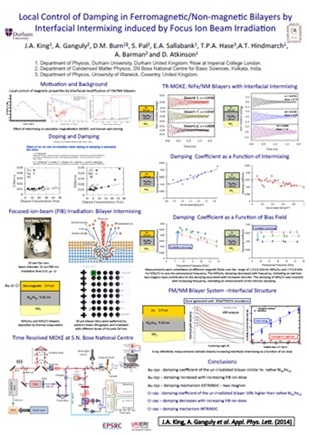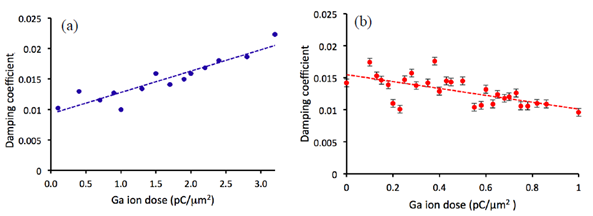
Local control of damping in ferromagnetic / non-magnetic bilayers by interfacial intermixing induced by focussed ion beam irradiaiton
J.A. King, A. Ganguly, D.M. Burn, S. Pal, E. Sallabank, T.P.A. Hase, A.T. Hindmarch, A. Barman and D. Atkinson
Durham UKIERI Workshop on magnetisation processes Durham Mar 2015
The control and understanding of magnetic damping is technologically desirable. For spin-transfer torque magnetic random access memory (STT-MRAM) and magnonic devices, lower damping allows a lower writing current and longer propagation of spin waves, while increased damping increases reversal rates and facilitates coherent reversal for fast switching in recording. In this work the influence of interfacial intermixing on the picosecond magnetization dynamics of ferromagnetic/nonmagnetic thin-film bilayers was studied. Low-dose focused-ion beam (Ga+) irradiation was used to induce intermixing across the interface between a 10 nm Ni81Fe19 layer and a 2-3 nm capping layer of either Au or Cr. Time-resolved magneto-optical Kerr Effect magnetometry was used to study magnetization dynamics as a function of ion-beam dose. With a Au cap the damping of the unirradiated bilayer was comparable with native Ni81Fe19 and increased with increasing ion dose. In contrast, for Ni81Fe19/Cr the damping was higher than that for native Ni81Fe19 but the damping subsequently decreased with increasing dose.
The high spatial resolution of the FIB technique combined with the capacity of very low irradiation doses to cause intermixing offers the ability to locally modify the precessional magnetisation behaviour of ferromagnetic materials on a micro- or nano-scale. (a) (b)

Figure 1. The damping coefficient, alpha, obtained from the TR-MOKE data as a function of FIB dose at H = 1.5 kOe for (a) NiFe/Au bilayer (error bars are smaller than the data points), (b) NiFe/Cr bilayer.